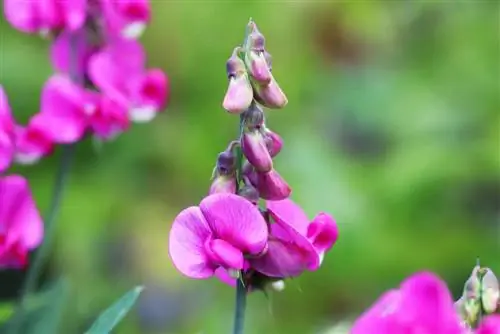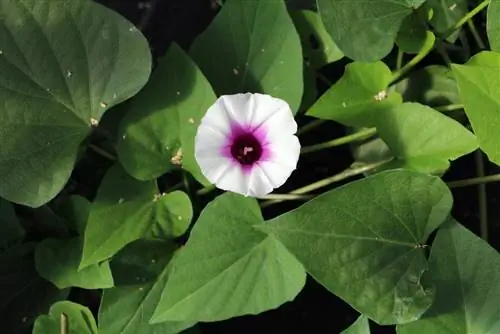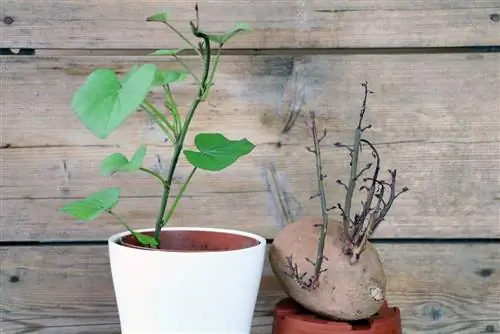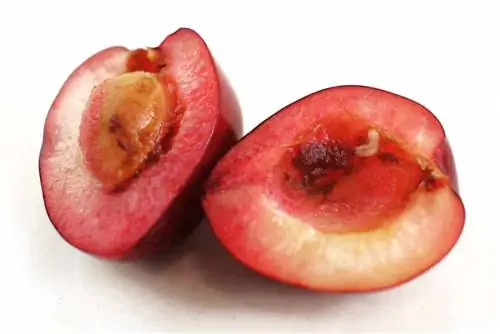- Author admin [email protected].
- Public 2023-12-17 03:39.
- Last modified 2025-01-24 12:45.
The hardy perennial vetch is suitable for climbing and also looks lovely as a cut flower.
Sowing and planting time of sweet peas
The seeds can be sown directly at the desired location. The best time is the beginning of spring. The fresh seeds should be planted mid-April to early May so that they show flowers in the summer. Before placing them in the ground, the vetch seeds should be soaked in lukewarm water for a few hours (preferably overnight). The plant forms the first germs after just three weeks. To grow the vetch seeds, they can be planted in a deep pot or on multi-pot plates.
The cultivation can begin as early as March in a cold frame, but can also be done in a greenhouse. It is worth cutting off the main shoot of the perennial vetch every now and then, as this supports growth and the plant produces more flowers. The perennial sweet peas are planted after the ice saints. If the plants are not pre-cultivated too warm, then planting can begin beforehand, as the fresh shoots of the perennial vetch can also tolerate light frost.
Location, care and soil for sweet peas
Perennial vetch develops best in moderately moist soil that is permeable and nutrient-rich. Sunny to partially shaded locations are best suited for the plant to develop splendidly. It is advisable to cut the plant again and again because this way it develops the greatest variety of flowers. When sowing for the first time, it is important to cut the plant again and again so that it does not set seeds. This is important for annual plants in the first year, because when they have formed the first seeds, the plant can die. Anyone who picks the plants not only has a beautiful bouquet, but also a full display of flowers after the first year. The soil should be fertilized from time to time with compost or organic fertilizer.
The perennial vetch is very robust and requires almost no care. However, regular watering ensures more abundant flowers. Pruning should be done in autumn. The perennial vetch is only cut back to the ground in spring. Sweet peas are climbing plants that require support in the form of climbing aids. To protect the garden perennial from twisting, tying the perennial in individual places on large plants can prevent it from breaking. Wire mesh can be used here, as can a fence or other climbing aid. If you do without the climbing aid, you will notice that the sweet peas are spreading upwards everywhere.
Pest infestation and diseases
Perennial sweet peas are robust, but can be attacked by snails or aphids. Collecting or running ducks helps against snail infestation. But pesticides also deter snails. If the perennial vetch is infected with aphids, the plant should be sprayed with a nettle broth. A mixture of dish soap and water in a 1:1 ratio also helps to rid the plant of annoying aphids. On very hot or rainy summer days, the perennial vetch can develop powdery mildew. However, this can easily be prevented with a regular water supply. It is best to water the plants in the evening when the sun has set. Seed beetles are also among the pests that deposit on the seed pods and can destroy the perennial vetch. The seed beetles lay eggs on the seed pods and flowers. The only thing that helps here is to completely remove the egg deposits. If the infestation is too large, the perennial vetch should be cut down completely and disposed of. It is best to burn the cut plants so that the seed beetles and eggs are actually destroyed.
Pruning, extending the flowering period and propagation
The perennial vetch propagates best if it is cut regularly during the flowering period. This prevents seeds from setting and new flowers continue to develop. This makes it possible to extend the flowering period until October. The perennial vetch reproduces practically by itself, so that it quickly fills a wide area of activity. Once the last flowers have faded at the end of autumn, pruning can begin. The plant is hardy and does not require any special care during the winter.
Transplanting sweet peas
The perennial vetch has a large root system that spreads quickly and can reach up to one meter into the ground. The best time to transplant perennial vetch is in spring. You dig up the perennial vetch with the roots and can then simply plant them in another location.
Wild and robust
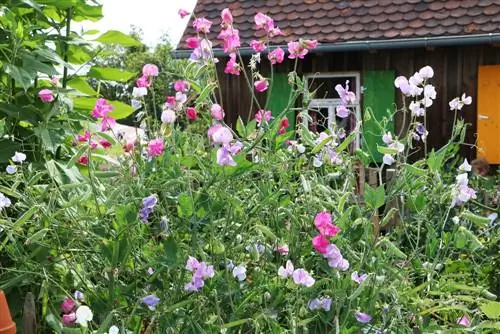
The perennial vetch is very robust, hardy and undemanding. The plant spreads quickly and provides a veritable sea of flowers until late autumn. The plant requires little care and with a few little tricks the plant will bloom several times in a year. The perennial vetch literally grows rampant and can easily be transplanted from one location to another. In addition to the sea of flowers in the bed, the perennial vetch can be cut again and again and thus also provides joy in the vase. Regular cutting has the positive side effect that more and more flowers appear.
What you should know about sweet peas in brief
- Veches and perennial vetches belong to the Leguminosae, Fabaceae.
- As the name suggests, the annual sweet pea exudes a wonderful scent.
- The perennial vetch, on the other hand, remains without a recognizable scent.
- Both species can be propagated very easily by sowing.
- The sweet pea is removed from the ground in autumn when the herb has died.
- The perennial vetch is only cut back a little.
- In spring you can cut the perennial vetch almost all the way down to the ground and it will sprout again.
- While the sweet pea can be found in many colors in the gardens, the perennial vetch only blooms white or pink.
- The perennial vetch is a very robust plant that can withstand strong winds. A climbing aid, trellis, rose arch or similar is required.
Both species make virtually no demands on the ground; the location can also be chosen as desired, although the splendor of the flowers has to be reduced to some extent in the shade. But if you want to achieve a particularly rich flowering, small amounts of fertilizer (horn shavings, compost) can't hurt. The perennial vetch in particular has time to process these fertilizer doses in autumn and spring. The sweet pea also likes to take a sip of the liquid fertilizer (follow the manufacturer's instructions when dosing).
- Vetch, whether sweet pea or perennial vetch, are very good cut flowers and last a long time in the vase.
- They look good next to other summer flowers, such as dahlias, roses, daisies, etc.
- They bloom continuously from June to October, and in mild weather even into November.
Sowing is best done directly on site in April to early May (when the soil is already frost-free). The seeds germinate in approximately 14-21 days. Prune young seedlings so they can branch. You can give the plants better support if you keep piling up the base of the plants a little, this stimulates root formation close to the ground and the plants don't bend over so easily. Sowing depth approx. 2-2.5 cm.

